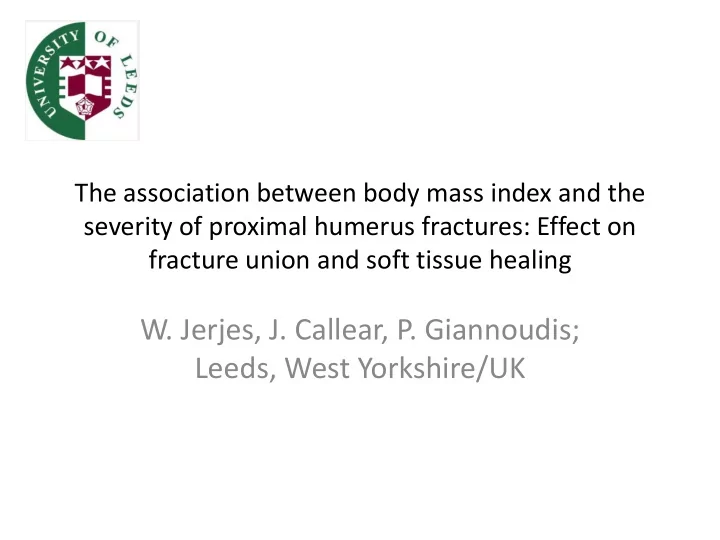

The association between body mass index and the severity of proximal humerus fractures: Effect on fracture union and soft tissue healing W. Jerjes, J. Callear, P. Giannoudis; Leeds, West Yorkshire/UK
Target group • Obesity to musculoskeletal problems. • Incidence of proximal humerus fractures. • Osteoporosis in the elderly. • Low-energy trauma - mechanical fall. • Postmenopausal females .
Study design • 5-Year period, 1752 patients - Females >45 years - Good health status 822 met the inclusion criteria - No mental health issues - Not diabetic - Nor neuromuscular weakness - Not requiring a walking aid - No history of falls or fractures • Classified according to their BMI • Neer classification • 82 patients underwent ORIF
1-part 2-part 3-part 4-part fracture fracture fracture fracture Underweight (n=6) 6 - - - Normal weight (n=156) 22 78 54 2 Overweight (n=552) 6 342 68 136 Obese (n=108) 5 29 43 31 Body mass index (4 categories) of the cohort and the fractures sustained as per the Neer classification system.
1-part 2-part 3-part 4-part 1-part 2-part 3-part 4-part n = 34 n = 423 n = 150 n = 102 n = 5 n = 26 n = 15 n = 67 Conservatively-treated Surgically-treated Wound healing Mean (weeks) 3 3 3 3 3 3 4 4 Min-Max 2-3 2-4 2-4 2-3 2-4 2-4 2-5 2-5 Standard Dev. ±1 ±1 ±1 ±1 ±1 ±1 ±2 ±2 Time to union Mean (weeks) 9 9 12 11 10 9 14 14 Min-Max 8-9 8-9 12-13 11-13 8-10 8-10 12-15 12-15 Standard Dev. ±1 ±1 ±1 ±1 ±1 ±2 ±1 ±2
1-part 2-part 3-part 4-part 1-part 2-part 3-part 4-part n = 34 n = 423 n = 150 n = 102 n = 5 n = 26 n = 15 n = 67 Conservatively-treated Surgically-treated Pain (4w) 3 31 22 34 0 5 4 23 Bleeding (4w) 0 0 0 0 0 2 1 6 Swelling (4w) 2 23 25 24 1 9 7 19 Inf.- superficial 0 4 2 1 0 3 1 2 Inf. – deep 0 0 0 0 0 2 2 14 Mal union 4 14 17 12 0 0 0 6 Delayed union 1 15 14 12 0 4 4 20 Non union 2 4 2 3 0 2 3 1 Neuro impair. 0 1 0 1 0 1 0 1 Comp. synd. 0 0 0 0 0 0 0 0
Number of patients 10 15 20 25 30 35 40 0 5 Pain (4w) Bleeding (4w) Conservatively-treated sub-group Swelling (4w) 1-part Inf.- superficial 2-part Inf. – deep 3-part Mal union Delayed union 4-part Non union Neuro impair. Comp. synd.
Number of patients 10 15 20 25 0 5 Pain (4w) Bleeding (4w) Surgically-treated sub-group Swelling (4w) 1-part Inf.- superficial 2-part Inf. – deep 3-part Mal union Delayed union 4-part Non union Neuro impair. Comp. synd.
Obesity • Traditional thoughts - reduced bone quality • Starvation – fracture • Obesity - osteoclastic microenvironment - Bone and calcium metabolism • Adipose tissue - hormonal effect • Location of fat deposition • Rate of fractures per skeletal site
Conclusion • Severity of the fracture is increased - Overweight - Obese - Postmenopausal females • Surgical fixation in 3-part, 4-part fracture - Delay in fracture union - Increase wound healing problems.
Thank you Questions?
Recommend
More recommend